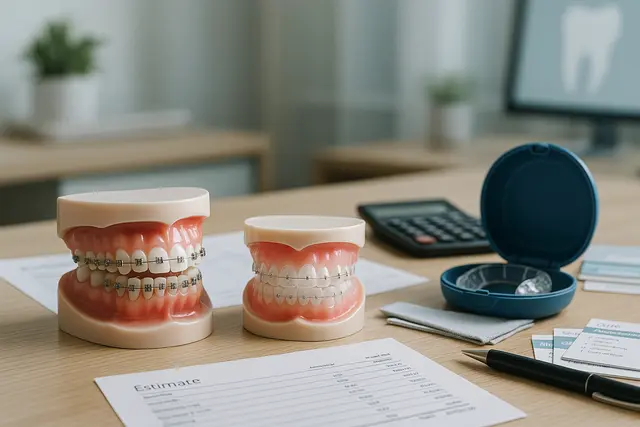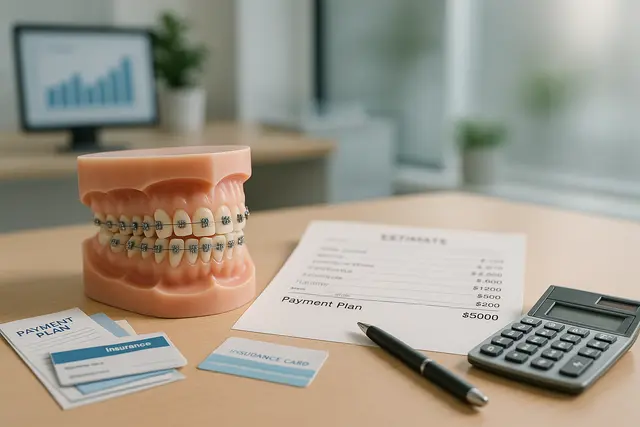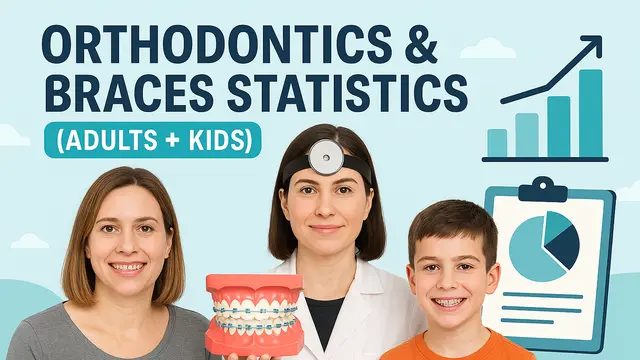Orthodontics
8 min read
Apr 02, 2025
Braces: Complete Guide to Types, Costs, and Treatment Process
Braces are one of the most common and effective tools in modern orthodontics. Whether for cosmetic improvement or correcting functional bite issues, braces have become a standard solution. The process is gradual, teeth are moved by applying continuous, gentle force over months or years.

Brace Basics: Why We Even Bother
If you’ve ever hidden your grin in a photo, a brace might feel less like metal and more like freedom. Braces can correct crooked teeth, crowded teeth, and gaps, steering every tooth into proper alignment so you bite, chew, and smile with zero stage fright. A brace isn’t just cosmetic; it also eases jaw strain, keeps plaque from hiding in tight corners, and helps you brush your teeth and floss without Olympic‑level contortions.
Because braces are an investment in long‑term oral health, orthodontists and dentists treat the decision with the same seriousness you give buying a car, only with far fewer salesman clichés.
Types of Braces: Your Menu of Options
The American Association of Orthodontists lists more choices today than your favorite streaming service. The main stars include traditional metal braces (metal brackets plus a trusty wire), ceramic braces with tooth‑colored or clear brackets (often called clear braces), self‑ligating braces that clip shut without neon elastic ties, lingual braces hidden on the back teeth, and clear aligners, removable trays that straighten your teeth without brackets and wires on show.
Different types of braces all rely on the same principle: braces put pressure on the teeth so bone gradually reshapes around them. Each brace available comes with pros, cons, and price tags that affect both your wallet and lifestyle.
How Braces Work: The Everyday Science
Think of a brace as an ever‑so‑polite personal trainer for your mouth. Metal brackets are cemented to your teeth; a flexible stainless‑steel or nickel‑titanium wire threads through those brackets; steady force to move teeth begins. As the wire tries to spring back to its original shape, it pulls each tooth along for the ride.
Tiny rubber bands or headgear may add extra pressure on the teeth if the orthodontist wants to shift your bite or widen the upper and lower arches. Over time, bone dissolves on the pressure side of each tooth and rebuilds behind it, exactly how nature makes room for that move. Visits to the orthodontist every four to eight weeks let the team adjust braces, change wires, or swap elastic bands so the force stays Goldilocks‑perfect.
Getting Braces: From Consultation to Celebration
Your first visit feels part detective story, part planning session. A dentist or orthodontist will give you a full exam, grab photos, take X‑rays, and maybe a 3‑D scan. They’ll map where every tooth lives now and where it should end up. If you need braces, you’ll discuss the type of braces available, estimated treatment time, and costs. Once you pick your brace, the big day comes: brackets are gently cemented to your teeth, the wire is threaded, and instructions are handed over on a silver platter (okay, a printed sheet).
Expect sore gums for a couple of days, brace work is a workout, and keep orthodontic wax handy to cover braces that rub. Within a week, you’ll barely notice the metal but you’ll absolutely notice food loves to hide around your brackets.
Tooth Tales: What Happens Above and Below the Gumline
A brace works hard, but your gums do most of the remodeling. Controlled pressure on the teeth nudges the periodontal ligament, the tissue connecting root to bone, and sparks tiny biological signals. Bone on the squeeze side dissolves; bone on the tension side builds up. Good oral hygiene is your best friend during this microscopic construction project.
Brush your teeth after every meal, floss at least once daily (around brackets, beneath wires, and under the gum edge), and swish water whenever you can. Skipping care invites plaque, cavity trouble, and swollen gums that slow down treatment with braces. Keep teeth and gums clean and your timeline stays on track.
Brackets, Wires, and All Those Tiny Parts
Metal brackets are made of metal alloys that shrug off corrosion and let a dentist or orthodontist sculpt tooth movement millimeter by millimeter. Ceramic brackets look nearly invisible because each bracket is tooth‑colored ceramic. Self‑ligating brackets have small clips, eliminating the need for colorful rubber bands, handy if you want sleek hardware.
The archwire holds the starring role: lighter round wires start gentle movement; heavier rectangular wires later refine the bite. Rubber bands (also called elastic bands) add force to move teeth between jaws. Orthodontic wax smooths edges when soft cheeks protest. Lose or break a bracket? Call the office, it’s not a catastrophe, but broken braces can drag out the calendar.
Orthodontic Know‑How: The Team and the Tools
Orthodontics blends physics with artistry. While your general dentist checks cavity risk, an orthodontist tackles alignment puzzles full‑time. An orthodontist may use computer modeling, digital simulations, and even 3‑D printed appliances to plan force to move the back teeth or rotate a stubborn incisor. The more complex your bite, the more you’ll appreciate specialty expertise.
Remember, braces requires patience and partnership: you show up, keep everything clean, and the orthodontist fine‑tunes hardware so the wire continues to put pressure on your teeth at just the right angle.
Lingual Braces: The Ninja Option
If you fear showing metal at all, lingual braces hide on the inside, cemented to your teeth instead of the front. Because brackets and wires must be custom‑shaped to fit the tongue side, costs run higher, and speaking clearly takes practice. Cleaning is also trickier. Yet for adult professionals who need discreet treatment with braces, lingual braces deliver stealth straightening without aligners you might forget to wear.
Ceramic Braces and Ceramic Choice Points
Ceramic braces substitute tooth‑colored ceramic for metal brackets so they blend with enamel. That tooth‑colored ceramic option calms self‑conscious teens and camera‑happy adults. They function similar to traditional braces, though ceramic is a bit bulkier and can chip if you chew pens or hard snacks. Some offices pair ceramic brackets with a frosted wire to double down on camouflage. Because ceramic brackets are more fragile, your orthodontist may tighten wires more slowly, slightly stretching the timeline.
Retainer Reality: Life After Active Braces
Pop the confetti when the brace hardware comes off, but don’t toss it yet, now the retainer era begins. A retainer holds each tooth in its new bone bed until everything stabilizes. Think of it as the final chapter that locks in months (or years) of effort. Skip nights with your retainer, and teeth can shift faster than you expect.
Clear removable braces‑style retainers look like aligners; Hawley retainers use acrylic and a wire across the front teeth; fixed retainers are thin wires bonded behind the top and bottom teeth. Your orthodontist will give instructions on wear time, cleaning, and when you might graduate to retainer‑only at night.
Floss, Brush, Repeat: Everyday Care
Around your brackets and wires, food loves to linger. Use floss threaders, orthodontic floss with stiff ends, or a water flosser to blast gunk away. Brush your teeth with a soft‑bristle brush angled 45 degrees toward the gum line and again toward the wire. Plaque doesn’t care if your brace is made of metal or ceramic; it only cares if you skip cleanup. Orthodontic wax is handy for cheek relief, but keep a travel kit with dental wax, a proxy brush, and floss in your bag so you can clean after lunch and avoid trapped spinach.
Do You Need Braces? Signs and Signals
Ask yourself: Do I bite my cheek? Do I hide a crooked smile? Does floss shred because my crowded teeth leave no wiggle room? If yes, you might need braces. An orthodontist evaluates bite alignment, crowding, spacing, open bites, overbites, underbites, and crossbites. Braces can correct issues that cause tooth wear, jaw pain, or speech challenges. Even mild shifting can snowball over years, so early advice saves stress later.
Braces Treatment Costs and Timeline
Costs vary by brace style, location, and complexity. Traditional metal braces remain budget‑friendly at roughly $3,000–$6,000, while ceramic braces add a few hundred dollars. Lingual braces and clear aligners can climb toward $8,000–$10,000, partly because lab fees and extra chair time pile up. Most orthodontic treatment spans 18–24 months, though simple tweaks run shorter and tough bites longer.
Insurance often chips in; many offices offer interest‑free payment plans. Braces are made of metal empathy, so never be shy about asking for a financial roadmap.
Braces Available Today and How to Choose
With all the types of braces available, decision fatigue hits fast. Start by ranking priorities: budget, appearance, treatment speed, and comfort. If you can’t remember to wear removable trays 22 hours a day, wired braces win.
If public speaking is your job, ceramic or lingual braces shine. Athletes who fear mouth cuts sometimes pair traditional metal braces with a custom sports mouth guard. Bring your lifestyle concerns to your orthodontist; together you’ll customize the brace and treatment plan you can actually stick with.
Braces Like…? Busting Popular Myths
Braces may set off airport metal detectors (nope), magnetize cutlery (nope), or ruin your dating life (double nope). Wired braces do make corn‑on‑the‑cob risky, but most foods survive with minor tweaks, slice apples, break chocolate bars, skip taffy that can damage your braces. Elastic bands look scary but only add gentle guidance. And no, you won’t talk like a robot forever; your tongue adjusts within a week.
The Wire‑Up on Comfort and Emergencies
A new wire feels tight for a day or two. Over‑the‑counter pain relievers and cold drinks tame sore gums. If a wire escapes and pokes your cheek, bend it back with a pencil eraser or clip the end with disinfected nail clippers, then add orthodontic wax until you see the office. Damage braces enough times and extra visits stretch the calendar, so avoid chewing ice, pens, or popcorn kernels. Broken braces aren’t doom, but quick repairs keep pressure on the teeth consistent.
Care of Your Braces: Daily Habits That Pay Off
Sugar plus plaque equals cavity, and cavities under brackets mean paused treatment while fillings happen. Stick to water and milk, limit soda, and rinse after coffee to dodge stains around braces. Around your braces, special brushes, tiny cylinder shapes, scrub between bracket and gum. Fluoride mouth rinse layers extra security. Cover braces during contact sports; a custom mouth guard protects brackets and lips alike. Follow these tips and you’ll celebrate on schedule.
Life After Braces: Smile Maintenance 101
Once retainers lock your bite in place, celebrate with crunchy toast and selfie marathons. Keep yearly dentist or orthodontist checkups; minor shifting can be caught early. Because bone remodels throughout life, wearing a retainer a few nights a week long‑term is cheap insurance. Brush your teeth twice daily, floss, and see your dentist every six months, habits that started during braces treatment continue to guard oral health forever.
Final Thoughts
Choosing a brace is part science, part lifestyle, and part patience marathon. Whether you pick traditional metal braces, tooth‑colored ceramic brackets, stealthy lingual braces, or clear removable braces, the goal is identical: straighten teeth, protect gums, and unleash a grin that never ducks behind a hand again. Partner with a skilled orthodontist, follow the care rules, and that confident smile arrives sooner than you think, no magic, just steady pressure on the teeth, a bit of humor, and a whole lot of teamwork.
What Are the Main Types of Braces Available Today?
There are several types, including traditional metal braces, ceramic braces, self-ligating braces, lingual braces (which go behind the teeth), and clear aligners. Each option varies in visibility, cost, comfort, and how they fit into your lifestyle, but all work by applying steady pressure to shift teeth gradually.
How Do Braces Actually Move My Teeth?
Braces apply constant, gentle pressure to your teeth through brackets and wires. This pressure causes bone to break down on one side and rebuild on the other, allowing your teeth to shift into better alignment over time. Regular adjustments help guide this process safely and effectively.
What Should I Expect at My First Braces Appointment?
Your orthodontist will take photos, X-rays, and possibly a 3D scan of your teeth. Once a treatment plan is set, they’ll cement brackets to your teeth, thread the wire, and provide care instructions. Some soreness is normal for a few days, but it fades as your mouth adjusts.
Are Braces Only for Cosmetic Fixes?
Not at all. Braces also improve bite alignment, reduce jaw strain, help prevent gum disease, and make cleaning your teeth easier. They’re a long-term investment in both appearance and oral health, not just a way to get a straighter smile.
Read Next
Related Posts

Orthodontics
Retainer That Looks like Braces: Benefits for Long-Term Alignment
A retainer might not get as much attention as braces, but it plays a crucial role in maintaining your smile after orthodontic treatment. Whether you're new to retainers or curious about the type that looks like braces, understanding their purpose and benefits is key to keeping your teeth aligned for the long haul.
6 min read
Sep 15, 2025

Orthodontics
How Much Are Metal Braces? Cost Comparison With Other Options
Thinking about getting braces but overwhelmed by the cost? You’re not alone. Orthodontic treatment can be a major investment, and understanding the different price points, from metal braces to clear aligners, can help you make a smart, confident decision.
5 min read
Sep 15, 2025

Orthodontics
Orthodontics & Braces Statistics (Adults + Kids)
Orthodontics has transformed from a niche medical service for teenagers into a booming sector that spans all ages. Today, both adults and children seek orthodontic treatment to improve their smiles, fix bite issues, and boost self-confidence.
4 min read
Aug 21, 2025
Don’t have time to research every dentist around you?
See why 30k+ patients trusted us